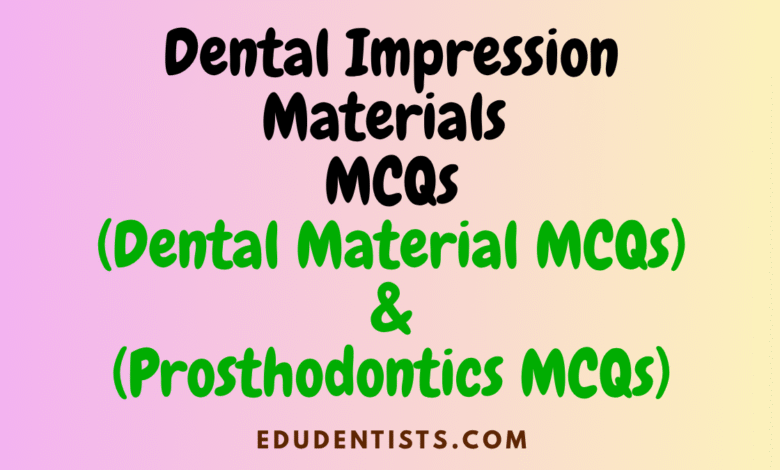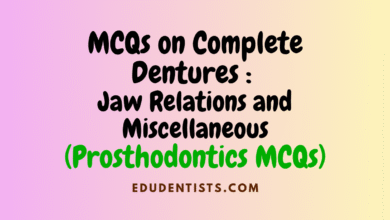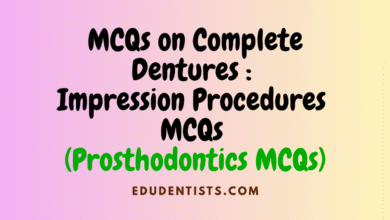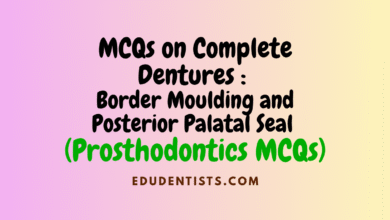Dental Materials MCQsProsthodontics MCQs
Dental Impression Materials MCQs

Dental Impression Materials MCQs
Dental Impression Materials MCQs
- 4th state of matter is:
A. Solid
B. Liquid
C. Gas
D. Colloid - All of the following statements about an alginate impression are EXCEPT:
A. It should be rapidly displaced from the mouth
B. It may exhibit fluid exudates on the surface as a result of imbibition of water
C. It will take up water and expand if kept wet
D. It will shrink as a result of syneresis - Type I and Type II zinc oxide impression paste differ with respect to:
A. Their use
B. Their hardness after setting
C. Water content
D. Eugenol content - The term given to the phenomenon of moisture absorption by an alginate impression in:
A. Imbibition
B. Syneresis
C. Hysteresis
D. Gelation - The impression with the least dimensional change upon disinfection is:
A. Addition poly silicon
B. Agar-agar
C. Polysulphide
D. Polyether - Palladium is added to polyvinyl siloxane to:
A. Act as a scavenger
B. Helps as surfactant
C. Acts as plasticizer
D. Acts as a catalyst - Immediate pouring of impressions is most critical in:
A. Condensation polysillicon
B. Addition Polysilicon
C. Polyether
D. A and B - The impression material used to record the prepared areas on abutment teeth is:
A. High viscosity elastomeric impression material
B. Medium viscosity elastomeric impression material
C. Low viscosity elastomeric impression material
D. None of the above - Alginate impression material is:
A. Non-elastic impression material
B. Thermoplastic impression material
C. More mucostatic than ZOE
D. Less mucostatic than - ZOE Syringe material is:
A. High viscosity elastomer
B. Medium viscosity elastomer
C. Medium & low viscosity elastomer
D. Low viscosity elastomer - The impression for a diagnostic cast of a partial edentulous mouth should be taken in:
A. Impression wax
B. Modelling compound
C. Hydro-colloid
D. Hydro cal - Agar impression materials differ from alginate impression materials in that the former sets by:
A. Mechanical action of saliva
B. Physical change
C. Evolution
D. Chemical change - Which material undergoes hysteresis ?
A. Irreversible hydrocolloid
B. Reversible hydrocolloid
C. Impression plaster
D. Metallic oxide paste - The setting time of irreversible hydrocolloids can be decreased by:
A. Raising the temperature of water used for maxing
B. Using excess water for maxing
C. Lowering the temperature of water used for mixing
D. None of the above - Rubber base impressions are poured immediately as they:
A. Continue to polymerize
B. Become elastic
C. Show imbibition and syneresis
D. Show gelation - The most mucostatic impression material is:
A. Thin mix of plaster of paris
B. Zinc oxide eugenol impression paste
C. Free flowing wax
D. Reversible hydrocolloids - The best way to remove a hydrocolloid impression from the patient’s mouth is:
A. Slight rocking of the impression to disengage it from the undercut
B. Wetting the periphery of the impression with moist cotton to break the peripheral seal
C. Sudden jerking of the impression to prevent tearing
D. Supporting the impression along with the tray to prevent disengaging of the tray alone - Palatal secretions affect the setting of all the impression materials except:
A. Silicone
B. Agar-agar
C. Impression paste
D. Impression plaster - Lenolin is added is ZOE paste to:
A. Decrease flow
B. Increase flow
C. Accelerate reaction
D. Decrease irritation due to eugenol - Agar is prepared from:
A. Bullock heart
B. Chemicals
C. Sea weed
D. Chick cells - Perforated impression tray are used for:
A. Alginate
B. Zinc oxide-eugenol
C. Agar-agar
D. Impression compound - During setting of alginate impression materials:
A. Trisodium phosphate reacts with sodium alginate
B. Trisodium phosphate reacts with calcium sulphate
C. Colloidal changes to sol
D. Material in contact with soft tissues sets last - K2SO4 in agar-agar is for:
A. Accelerating the setting stage of gypsum
B. Increase strength
C. Give dimensional stability
D. None of the above - Wash or corrective impression is done by:
A. Impression plaster
B. Impression paste
C. Alginate
D. Rubber base impression material - The plasticizers used in polyether impression material is:
A. polyether polymer
B. Colloidal silica
C. Glycol ether
D. Di-vinyl poly (dimethyl siloxane) - In reversible hydrocolloid the property by which the transformation from sol to gel and gel to sol is a function of the:
A. Concentration of filler and plasticizer
B. Percentage composition by weight of water
C. Concentration of potassium sulphate
D. Temperature - Alginates are:
A. Sol
B. Gel
C. Hydrocolloid
D. Colloid - Syneresis is associated with:
A. Hydrocolloids
B. Elastomers
C. Zinc oxide eugenol
D. Plaster of paris - The advantage of ZOE impression paste:
A. Has dimensional stability
B. Does not adhere to tissues
C. Is easy manipulation
D. Does not require special trays - Rinsing of the impression is important to:
A. Remove excess impression material
B. Remove saliva
C. Hydrate the impression
D. Accelerate the setting - Which is best material for RPD impression:
A. Impression plaster
B. Irreversible hydrocolloid
C. Reversible hydrocolloid
D. None of the above - Which of the following is not affected by saliva?
A. Impression plaster
B. Impression paste
C. Silicon impression material
D. None of the above - Retarder in Zinc oxide eugenol is:
A. CaCl2
B. Zinc acetate
C. Alcohol
D. Glycerin - The cross linking agent of polysulphide rubber base impression material is:
A. Aromatic sulfonate esters
B. Stannous octate
C. Platinum salt catalyst
D. Lead dioxide - When making a polysulphide impression for a caste crown, custom trays are usually preferred over stock trays for all of the following reasons except:
A. Custom trays facilitate uniform contraction of impression material
B. Custom trays require less impression material
C. Stock trays may be short in the flange area
D. Impressions made in the custom trays are easier to remove from the mouth - Name the accelerator used in Zinc oxide eugenol paste:
A. Olive oil
B. Linseed oil
C. Zinc acetate
D. All of these - Linear contraction of elastomeric impression with passage of time is highest in:
A. Addition silicone
B. Polysulphide
C. Polyetner
D. Condensation silicone - Which of the following is true about Agar hydrocolloid impression material?
A. Liquefies between 71 – 100°C
B. Solidfies between 50 – 70°C
C. Facilitates fabrication of metal dyes
D. Cannot register fine surface details - Which one of the following increase the strength and reduce viscosity of agar hydrocolloid impression material?
A. Borax
B. Water
C. Sulfates
D. Carbonates - The water powder ratio of alginate is?
A. 100 ml of water to 60 gms of powder
B. 40 ml of water to 40 gms of powder
C. 40 ml of water to 15 gms of powder
D. 15 ml of water to 40 gms of powder - Best impression material to be used for securing impression after crown preparation:
A. Alginate
B. Agar
C. Elastomer
D. Zinc oxide paste - Which of the following is correct glass transition temperature of Impression compound?
A. 43.5°C
B. 39°C
C. 65°C
D. 100°C - Rough and irregular surface produced on the impression is because of:
A. Air incorporated during mixing
B. Improper application of pressure during impression making
C. Presence of excessive saliva in impression area
D. Due to improper ratio of polymer and monomer - Minimum flow of Type-I impression compound at mouth temperature is?
A. 4%
B. 6%
C. 8%
D. 10% - Polysulfide material is routinely not recommended because of:
A. Unpleasant odor and taste
B. Low accuracy
C. Least permanent deformation
D. Highest curing shrinkage - Hydrocolloid material, show all except:
A. Hysteresis
B. Imbibition
C. Recrystallization
D. Syneresis - Impression material that Do NOT harden by chemical reaction:
A. Zinc oxide eugenol
B. Impression compound
C. Alginate
D. Plaster of paris - Putty wash technique:
A. Light body and putty used at the same time
B. Putty used first and light body used second
C. Light body first and putty later
D. None of the above - What is the minimum thickness of the elastomeric impression material for an accurate impression:
A. 2 mm
B. 2-4 mm
C. Greater than 3 mm
D. Maximum in the area of operation - The relative hardness of elastomer is determined using:
A. Rockwell tester
B. Barcol indenter
C. Knoop pyramid
D. Shore durometer - Rough surface of elastomeric impression results from:
A. Inadequate mixing
B. Air bubbles
C. Too rapid polymerization
D. Incomplete polymerization caused by premature removal from mouth - Most rigid elastomer is:
A. Polyether
B. Polysulphide
C. Addition silicone
D. Condensation silicone - Most ideally elastic among the following:
A. Polyether
B. Addition silicone
C. Polysulphide
D. Condensation silicone - Which one of the following impression materials is elastic, sets by a chemical reaction and is catalyzed by chloroplatinic acid:
A. Condensation silicone
B. Polyether
C. Polysulfide
D. Poly vinyl siloxane - Which of the following best describes the working time of elastomeric impression material?
A. After the start of appearing elastic properties of impression material
B. Just after the start of appearing elastic properties of impression material
C. Just before the start of appearing elastic properties of impression material
D. Loss of luster of impression material - Final product in alginate is:
A. Sodium alginate
B. Potassium alginate
C. Trisodium phosphate
D. Calcium alginate - Dustless alginate is produced by:
A. Reducing the diatomaceous earth
B. Adding heavy metal salts
C. Coating with dihydric alcohol
D. Altering the matrix - Two in one stage impression materials include:
A. Zinc Oxide eugenol impression paste
B. Hydrocolloid impression material
C. Elastomeric impression material
D. All of the above - A technique of combining reversible and irreversible hydrocolloid that could bond to irreversible hydrocolloid is known as:
A. Injecting technique
B. Laminate technique
C. Immersion technique
D. Tempering technique - Which of the following impression materials is easy to pour and difficult to remove the stone cast from the impression:
A. Addition polysilicone
B. Condensation polysilicone
C. Polyether
D. Polysulfide - Rough and irregular surface produced on the impression is because of?
A. Improper application of pressure during impression making
B. Air incorporated during mixing
C. Too rapid polymerization
D. Presence of moisture in impression area - The impression materials with lowest viscosity is?
A. Plaster of paris
B. Agar – agar
C. Zinc oxide eugenol
D. Elastomers - The ranking of tear strength from the lowest to highest of all impression materials generally is as follows:
A. Hydrocolloids, silicones, polyether, polysulfide.
B. Silicones, hydrocolloids, polyether, polysulfide.
C. Polysulfide, hydrocolloids, silicones, polyether
D. Hydrocolloids, polyether, silicones, polysulfide - Most mucostatic among the following?
A. Impression compound.
B. Alginate
C. ZOE paste
D. Elastomer - Which of the following impression material requires a hardener ?
A. Agar
B. Alginate
C. Elastomers
D. Impression compound - By product of condensation reaction between silicone base and alkyl silicate in presence of tin octate:
A. Ethyl alcohol
B. Glycol
C. Acetate
D. Propanolol - Which of the following component acts as an accelerator in ZOE impression paste?
A. Zinc Sulphate & Zinc chloride
B. Zinc chloride & Eugenol
C. Zinc Sulphate & Eugenol
D. Glycerin - Dimensional stability of elastomeric impression material can be given in descending order as?
A. Polysulphide > polyether > Condensation silicone > Addition silicone
B. polyether > Condensation silicone > Polysulphide > Addition silicone
C. Addition silicone > polyether > Polysulphide > Condensation silicone
D. Addition silicone> Condensation silicone > Polysulphide > polyether - A laminate impression technique utilize?
A. Syringe agar and chilled tray alginate
B. Syringe agar and tray agar
C. Syringe agar and impression compound
D. Chilled alginate and impression compound - Most flexible impression material?
A. Impression compound
B. Impression paste
C. Addition silicone
D. Alginate - Which of the following is correct arrangement of impression material regarding linear contraction in ascending order?
A. Addition silicone < polyether < polysulfide < condensation silicone
B. Addition silicone < polysulfide < Polyether < condensation silicone
C. Condensation silicone < polyether < polysulfide < Addition silicone
D. Condensation silicone < polysulfide < polyether < Addition silicone - Which of the following best describes the working time of impression material?
A. After the start of appearing elastic properties of impression material
B. Just after the start of appearing elastic properties of impression material
C. The time for start of mixing till just before the start of appearing elastic properties of impression material
D. Loss of lusture of impression material - Which of the following is used as surface hardener in Impression material?
A. 2% Potassium sulfate
B. 0.2% Potassium sulfate
C. 2% sodium sulfate
D. 4% Potassium sulfate - Which of the following is correct regarding chemical setting of condensation silicone?
A. Polymerization occurs with repeated elimination of small molecules
B. Polymerization occurs with elimination of single byproduct
C. By condensation of repeated molecules of monomers
D. Condensation does not occur at all - Dimensional stability of hydrocolloid impressions may be achieved by?
A. Using less water powder ratio
B. Storing the impression under water
C. Prolonged manipulation
D. Using humidor - To make the vinyl Polysiloxane hydrophilic the following is added?
A. Mineral oil
B. Surfactant
C. Water
D. Plasticizer - The role of magnesium chloride in zinc oxide eugenol impression paste?
A. Retarder
B. Modifier
C. Plasticier
D. Accelerator - Alginates are made dust free by adding?
A. Glycol
B. Glyecrol
C. Glutamic acid
D. Alcohol - The process of changing the rubber base product or liquid polymer, to a rubber like material is generally known as?
A. Boiling
B. Condensation
C. Vulconization
D. Chain lengthening - Which of the following is not true about elastomeric impression?
A. Single mix material have higher viscosity
B. Shear thinning is related to viscosity of non phase impression material
C. Improper mixing of material can cause permanent deformation of impression
D. Putty – wash technique of impression reduces dimensional change of setting - Impression compound is characterized by all of the following except?
A. Warps at room temperature
B. Is a thermoset material
C. Shows increased flow when kneaded with water
D. Low coefficient of thermal conductivity - Rapid removal of rubber impression with a single firm motion results in?
A. Reduced dimensional instability
B. Improved adhesion of the impression to the tray
C. Minimal permanent deformation
D. Reduced contamination by saliva - Which of the following impression material is rigid?
A. Zinc oxide-eugenol
B. Reversible hydrocolloid
C. Alginate
D. Polysulphide rubber - Elastomers except: Polyether are?
A. Hydrophilic
B. Hydrophobic
C. Water loving impression materials
D. Potassium alginates - Hardening solutions are used with impression made of?
A. Hydrocolloid
B. Impression compound
C. Elastomer
D. Zinc oxide eugenol - Alginate impression material is similar to Agar-agar impression material in the following respect?
A. Gelation increase in both on increase in temperature
B. Mixing time is increased to reduce the setting time
C. Deformation during removal of impression occurs due to distortion of gel fibers
D. Both can be re-used for fresh impressions - Gelation temparature of agar is between?
A. 20°C to 25°C
B. 27°C to 33°C
C. 37°C to 50°C
D. 55°C to 60°C - Brush heap structure is found in?
A. Zinc oxide impression material
B. Agar
C. Condensation silicone
D. Polyether - Masterial causing minimum tissue distortion is?
A. Polysulphide
B. Silicone
C. Impression plaster
D. Zinc oxide eugenol paster - Inelastic impression material is?
A. Impression compound
B. Alginate
C. Agar-agar
D. Polyether - One of the most important advantages of truly elastic impression material would be its capacity for?
A. Close adaptation to soft tissues
B. With drawl without permanent distortion
C. Reproduction of surface details
D. Compatibility with gypsum products - Impression compound base
A. Low thermal conductivity
B. Crystalline structure
C. Formation of cross linkage with heating
D. High fusion temperature - Hypersensitivity reactions like contact dermatitis can be caused by?
A. Polysulfides
B. Condensation silicones
C. Addition silicones
D. Polyether - Trisodium phosphate in alginate acts are?
A. Retarder
B. Reactor
C. Accelerator
D. Plasticizer - Which of the following impression material is elastic?
A. Impression compound
B. Zinc Oxide eugenol (ZOE) paste
C. Wax
D. Polyvinyl siloxane - The American dental association (ADA) specification number for non-aqueous elastomeric dental impression material is?
A. 19
B. 20
C. 21
D. 26 - Elastomers are?
A. Alginate
B. Agar
C. Polyethers
D. Imp. Compound - Tear strength for impression material is highest for?
A. Condensation silicone
B. Alginate
C. Polysulfide
D. Addition silicone - Trisodium phosphate added to alginate contributes towards?
A. Increasing the working time of alginate impression material
B. Acts as an accelerator
C. Initiating the setting reaction
D. Provides gel strength - Agar syringe material can be used with/as?
A. Agar
B. Alginate impression material
C. Both of the above
D. Primary impression - Impression compound has which of the following characteristic property?
A. Low thermal conductivity
B. High flow property
C. Degradation is presence of moisture
D. Remain distortion free up to 72 hrs. pouring can be safely delayed - Heavy and light body impression materials are use with?
A. Mercaptan
B. Silicone
C. Reversible hydrocolloid
D. A and B - Which material is the most difficult to remove from the patients mouth?
A. Metallic oxide paste
B. Silicone impression material
C. Reversible hydrocolloid
D. Impression plaster - Before pouring an elastic impression it is washed with slurry of water and stone to?
A. Increase gel strengt
B. Prevent syneresis
C. Prevent distortion
D. Wash off saliva on impression - The basic constituent of reversible hydrocolloid impression material is?
A. Agar
B. Alginic acid
C. Gelatin
D. Dlginate - Sol – gel transformation is seen in?
A. Impression plaster
B. Hydrocolloids
C. Elastomer
D. Impression compound - Setting time of ZOE is best controlled by?
A. Adding a drop of eugenol
B. Adding a drop of water
C. Cooling the glass slab
D. Altering ratio of two pastes - Impression plaster is?
A. Less compressive than alginate
B. More compressive than alginate
C. As compressive as alginate
D. More compressive than hydrocolloids - Vulcanization refers to the setting of?
A. Reversible hydrocolloid
B. Mercaptan impression material
C. Zinc Phosphate cement
D. Zinc oxide-eugenol - Impression techniques are used for recording?
A. Oral mucosal tissues
B. Dental hard tissues
C. Oral mucosal tissues and dental hard tissues
D. None of the above - Syneresis seen in hydrocolloid gel is?
A. Seen as water loss
B. Water absorption
C. Shrinkage
D. Gelation - Best material for duplicating cast is?
A. Agar-agar
B. Alginate
C. Zinc oxide eugenol
D. Plaster of paris - The base paste of the condensation poly sillicone has a low molecular weight dimethyl siloxane with a terminal-group?
A. Marcaptan group
B. Hydroxyl group
C. Silane group
D. Virryl group - Hysteresis in a hydrocolloid gel is?
A. Moisture absorption
B. Temperature lag between gelation and liquefaction temperature
C. Phenomenon of conversion of gel into sol
D. All of the above - All of the following can be used to slow down the setting of Zinc oxide eugenol impression paste EXCEPT?
A. Adding a small amount of glycerine
B. Adding a small amount of water
C. Altering the amounts of the two pastes used
D. Cooling mixing slab - All of the following statements about Type II silicon impression material are true EXCEPT?
A. They evolve hydrogen when cast if they are not fully cured
B. They exhibit a very low setting shrinkage
C. They have a lower tear resistance than polysulphide rubbers
D. They set by condensation polymerisation - The Zinc oxide-eugenol impression pastes harden by:
A. Chemical reaction
B. Cold
C. Heat
D. Pressure





